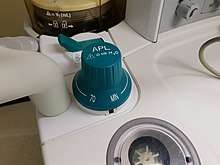Adjustable pressure-limiting valve
An adjustable pressure-limiting valve (commonly abbreviated to APL valve, and also referred to as an expiratory valve, relief valve or spill valve) is a type of flow control valve used in anaesthesiology as part of a breathing system. It allows excess fresh gas flow and exhaled gases to leave the system while preventing ambient air from entering.[1]

Such valves were first described by the American anaesthesiologist Jay Heidbrink, who used a thin disc that was held in place by a spring.[2] The valve is adjustable and spring-loaded, allowing the opening pressure of the valve to be controlled by screwing the valve top which modifies the pressure on the spring.[1] A very light spring is used, so that at its minimum setting the valve can be opened by the patient's breathing alone using low pressures.[3] In contemporary APL valves, three orifices or "ports" are present: one for intake of gas, one for return of gas to the patient, and an exhaust port for waste gas which can be connected to a scavenging system.[1]
References
- Baha Al-Shaikh; Simon Stacey (2013). "Breathing systems". Essentials of Anaesthetic Equipment. Elsevier Health Sciences. pp. 55–73. ISBN 0-7020-4954-9.
- Steven M. Yentis; Nicholas P. Hirsch; James K. Ip (2013). "Adjustable pressure-limiting valves". Anaesthesia and Intensive Care A-Z: An Encyclopaedia of Principles and Practice. Elsevier Health Sciences. p. 12. ISBN 0-7020-4420-2.
- Davis, Paul D; Kenny, Gavin N C (2003). "The Interrelationship of Pressure and Force". Basic Physics and Measurement in Anaesthesia. Butterworth-Heinemann. p. 3. ISBN 978-0-7506-4828-8.